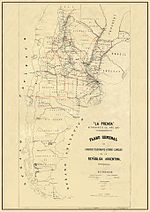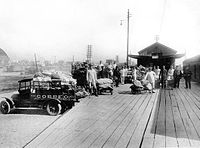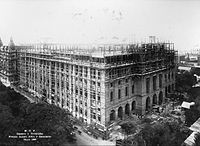| Correo Oficial de la República Argentina | |
 | |
 The Buenos Aires Central Post Office, former seat of Correo Argentino | |
| S.A. overview | |
|---|---|
| Formed | 1 July 1826; 198 years ago (1826-07-01) |
| Jurisdiction | National |
| Headquarters | Edificio French, Buenos Aires |
| Motto | Todo lo que das, llega |
| Employees | 18,000 (2018) |
| Annual budget | A$ 17,752 million |
| S.A. executives |
|
| Parent department | Office of the Cabinet Chief |
| Website | correoargentino.com.ar |
The Official Post Service of the Argentine Republic (Spanish: Correo Oficial de la República Argentina, mostly known as Correo Argentino since it was privatized in 1997) is the state-owned company that covers the postal service in Argentina. The company is a S.A. under the country's Office of the Cabinet Chief.
History
The beginning: Viceroyalty

On 14 May 1514 the "Correo Mayor de Indias", headquartered in Lima, Peru, was created. Under the mandate of Carlos III of Spain the post service became part of the Viceroyalty of the Río de la Plata depending on the Kingdom of Spain. With the commercial activity increasing considerably, it was decided to create a post service at Buenos Aires. Domingo Basavilbaso made the arrangements to establish a post service in the region. It would be managed by a senior lieutenant designed by the head office at Lima.
On 1 July 1769, the service began its activities officially. Through the years it extended to the cities of Potosí and Santiago (Chile). Bruno Ramírez was the first postman of Argentine post, when the profession did not still exist in the country. Ramírez officially became post employee on 14 September 1771. Years later that would be promulgated as the Day of Postman in Argentina.
Evolution

Post service in Argentina played a key role during the May Revolution because of orders and reports from the Primera Junta were distributed through letters. The first manager of the service was Melchor de Albín, designed in June 1810.
In 1826, during the presidency of Bernardino Rivadavia, the service was nationalised by a Law passed by the Congress of Provincias Unidas del Río de la Plata. Since then, the post service was named "Dirección General de Correos, Postas y Caminos", with Juan Manuel de Luca in charge. De Luca remained during 32 years, being succeeded by Gervasio Antonio de Posadas. It was Posadas who placed the first post boxes in the city of Buenos Aires, wrote the rules for postmen and established lower prices for post rates.
Eduardo Olivera was chosen as director in 1874 replacing Posadas. Olivera wrote the new rules and sent a project for the Law of renew of post services, n° 816. During successive administrations, money orders, courier services, registered letters and declared values were implemented. After being an agency depending on the Ministries of Finances and Interior, in June 1944 the Government of Argentina established the post service autonomy, naming it "Dirección General de Correos y Telecomunicaciones" (National Direction of Post and Telecommunication)
Palacio de Correos
Main article: Buenos Aires Central Post Office
Due to the increasing demand for post services in Argentina, in 1888 the Post Office director, Ramón Cárcano, proposed a specific building as seat for the postal service. French architect Norbert-Auguste Maillart designed the building, inspiring in the City Hall Post Office of New York City.
Works started in 1889, not being finished until 1928 when the building was officially inaugurated by president of Argentina Marcelo T. de Alvear.
ENCoTel
The "Empresa Nacional de Correos y Telégrafos" (ENCoTel) (in English: "Post and Telegraph National Company") was a state-owned company established in 1972 for post, telegraph and money services. During the National Reorganisation Process started in 1976, private companies were allowed to take part in post services, although the universal post services continued being managed by the state post.
Privatisation

In 1997, during the Carlos Menem administration, ENCoTel was privatised. The service was granted in concession to "Correo Argentino", a company part of Sociedad Macri (SOCMA), owned by businessman Franco Macri. In that way, Argentina became one of the first countries to privatise its post service. The contract of concession set a term of 30 years, also establishing that SOCMA would pay a six-monthly rent of A$ 51.6 million to the state. Nevertheless, the consortium built up a debt of nearly US$900 million to private creditors and the state as well. In September 2001, SOCMA entered into a reorganization proceeding.
The Palacio de Correos was declared National Heritage by Law 12,665 in 1997. considering its architectural style and historic relevance. In 2002 the building ceased operations as seat of Correo Argentino. Only a small part of the building continued its activities as a post office and sale of stamps, on Sarmiento street. The rest of the building became inactive until became the Kirchner Cultural Centre in 2015.
Renationalization
The Kirchner administration decided in 2003 that Correo Argentino would go back to state administration for 180 days, while a new private administrator would be sought for in an international public bid. In 2004, the re-privatization plan was halted, and a new state-owned S.A. corporation was created: Correo Oficial de la República Argentina Sociedad Anónima. In 2005, the concession was officially taken from Macri. Franco Macri, a supporter of the Kirchner administration, claimed he received an unworthy treatment during the process.
See also
- Buenos Aires Central Post Office
- Kirchner Cultural Centre
- Postal codes in Argentina
- Communications in Argentina
- Postal Union of the Americas, Spain and Portugal
- Universal Postal Union
References
- Nuestra historia on Correo Argentino website
- Condiciones generales on Correo Argentino
- La empresa con más empleados en el país es estatal: Trenes Argentinos at Clarín, 8 May 2022
- ^ Una militante de la Cámpora, al correo by Andrés Sanguinetti, iProfesional, 8 Jan 2020
- Gobierno de la empresa on Correoargentino.com.ar
- Efeméridas culturales en Argentina, Ministerio de Educación
- Juan Manuel de Luca Archived 2016-03-04 at the Wayback Machine, Biblioteca Nacional
- "Empresa Nacional de Correos y Telegrafos: Su privatización por concesión", Infoleg
- "De la patria contratista al control mismo del Estado" Archived 2013-02-17 at the Wayback Machine, Infoleg, 31 Jan 2013
- "Correo Argentino: la primera empresa re estatizada" Archived 2015-05-24 at the Wayback Machine, Primera Página Bonaerense, 31 May 2013
- "Ley 12.665 - COMISION NACIONAL DE MUSEOS, MONUMENTOS Y LUGARES HISTORICOS". Archived from the original on 2015-07-14. Retrieved 2015-07-14.
- "El Palacio de Correos dejó de recibir y de distribuir cartas", La Nación, 7 Sep 2002
- La Presidenta inauguró el “Centro Cultural Néstor Kirchner” on Argentina.gob.ar, 22 May 2015
- "Macri recibió aviso de retorno al Estado". Página 12 (in Latin American Spanish). 20 November 2003.
- "Renegociación de servicios públicos: le sacarán la concesión al grupo Macri. El Correo Argentino volverá a ser estatal por 180 días". La Nación (in Latin American Spanish). 13 November 2003.
- Kirchner, Néstor; Fernández, Alberto; De Vido, Julio (11 June 2004). "Decreto DNU 721 / 2004" [Decree 721/2004]. Argentina.gob.ar (in Latin American Spanish). Executive of Argentina. Retrieved 2020-11-22.
- "Por decreto Correo Argentino pasará a ser una sociedad anónima". Ámbito Financiero (in Latin American Spanish). 10 June 2004.
- "Otra compañía pública. Crean una empresa estatal para manejar el Correo". La Nación (in Latin American Spanish). 12 June 2004.
- Stang, Silvia (12 February 2005). "Servicios públicos: la concesión le fue quitada al grupo Macri. El Gobierno no devolverá el Correo a manos privadas". La Nación (in Latin American Spanish).
- "Cómo Kirchner y Moreno estatizaron el Correo, según Franco Macri". Perfil (in Latin American Spanish). 9 February 2017.
External links
| Government of Argentina | |||||
|---|---|---|---|---|---|
| Executive |  | ||||
| Legislative | |||||
| Judiciary | |||||
| Ministries |
| ||||
| Secretariats | |||||
| Agencies | |||||
| Companies |
| ||||
| Communications | |||||
| Armed Forces | |||||
| Law enforcement | |||||
| Mail and postal systems | ||
|---|---|---|
| History |  | |
| Components | ||
| Delivery | ||
| Staff | ||
| Processing | ||
| Institutions and systems | ||
| Related | ||
| List of entities that have issued postage stamps | ||
| ||